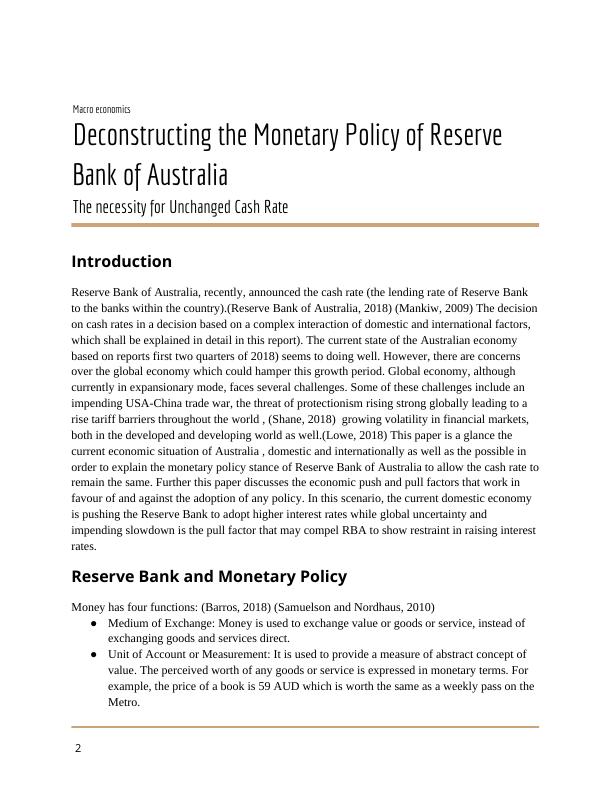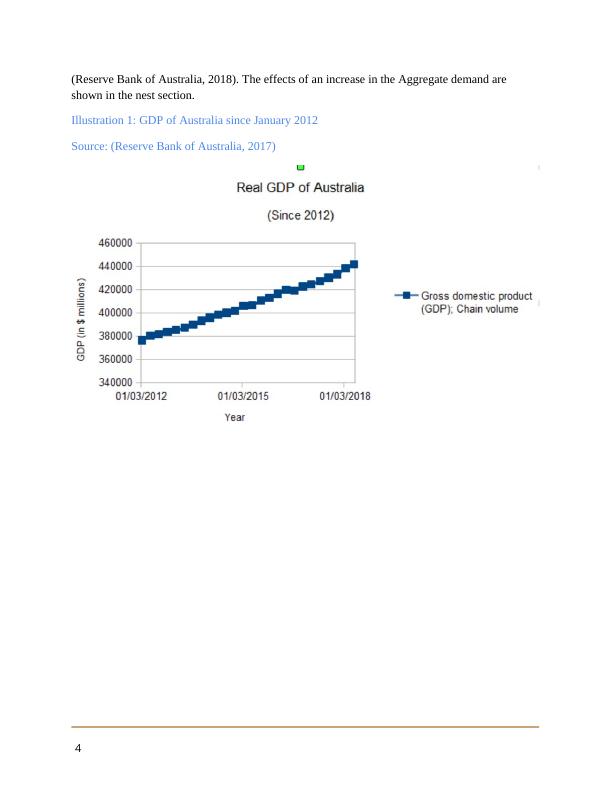Deconstructing the Monetary Policy of Reserve Bank of Australia
Added on 2023-06-04
13 Pages3288 Words316 Views
Introduction 1
The State of Australian Economy: Current and Recent Past 2
The Effects of an Expansionary Monetary Policy 4
Effects of a Contractionary Monetary Policy 5
Economic Growth 6
Conclusion 6
The State of Australian Economy: Current and Recent Past 2
The Effects of an Expansionary Monetary Policy 4
Effects of a Contractionary Monetary Policy 5
Economic Growth 6
Conclusion 6

Macro economics
Deconstructing the Monetary Policy of Reserve
Bank of Australia
The necessity for Unchanged Cash Rate
Introduction
Reserve Bank of Australia, recently, announced the cash rate (the lending rate of Reserve Bank
to the banks within the country).(Reserve Bank of Australia, 2018) (Mankiw, 2009) The decision
on cash rates in a decision based on a complex interaction of domestic and international factors,
which shall be explained in detail in this report). The current state of the Australian economy
based on reports first two quarters of 2018) seems to doing well. However, there are concerns
over the global economy which could hamper this growth period. Global economy, although
currently in expansionary mode, faces several challenges. Some of these challenges include an
impending USA-China trade war, the threat of protectionism rising strong globally leading to a
rise tariff barriers throughout the world , (Shane, 2018) growing volatility in financial markets,
both in the developed and developing world as well.(Lowe, 2018) This paper is a glance the
current economic situation of Australia , domestic and internationally as well as the possible in
order to explain the monetary policy stance of Reserve Bank of Australia to allow the cash rate to
remain the same. Further this paper discusses the economic push and pull factors that work in
favour of and against the adoption of any policy. In this scenario, the current domestic economy
is pushing the Reserve Bank to adopt higher interest rates while global uncertainty and
impending slowdown is the pull factor that may compel RBA to show restraint in raising interest
rates.
Reserve Bank and Monetary Policy
Money has four functions: (Barros, 2018) (Samuelson and Nordhaus, 2010)
● Medium of Exchange: Money is used to exchange value or goods or service, instead of
exchanging goods and services direct.
● Unit of Account or Measurement: It is used to provide a measure of abstract concept of
value. The perceived worth of any goods or service is expressed in monetary terms. For
example, the price of a book is 59 AUD which is worth the same as a weekly pass on the
Metro.
2
Deconstructing the Monetary Policy of Reserve
Bank of Australia
The necessity for Unchanged Cash Rate
Introduction
Reserve Bank of Australia, recently, announced the cash rate (the lending rate of Reserve Bank
to the banks within the country).(Reserve Bank of Australia, 2018) (Mankiw, 2009) The decision
on cash rates in a decision based on a complex interaction of domestic and international factors,
which shall be explained in detail in this report). The current state of the Australian economy
based on reports first two quarters of 2018) seems to doing well. However, there are concerns
over the global economy which could hamper this growth period. Global economy, although
currently in expansionary mode, faces several challenges. Some of these challenges include an
impending USA-China trade war, the threat of protectionism rising strong globally leading to a
rise tariff barriers throughout the world , (Shane, 2018) growing volatility in financial markets,
both in the developed and developing world as well.(Lowe, 2018) This paper is a glance the
current economic situation of Australia , domestic and internationally as well as the possible in
order to explain the monetary policy stance of Reserve Bank of Australia to allow the cash rate to
remain the same. Further this paper discusses the economic push and pull factors that work in
favour of and against the adoption of any policy. In this scenario, the current domestic economy
is pushing the Reserve Bank to adopt higher interest rates while global uncertainty and
impending slowdown is the pull factor that may compel RBA to show restraint in raising interest
rates.
Reserve Bank and Monetary Policy
Money has four functions: (Barros, 2018) (Samuelson and Nordhaus, 2010)
● Medium of Exchange: Money is used to exchange value or goods or service, instead of
exchanging goods and services direct.
● Unit of Account or Measurement: It is used to provide a measure of abstract concept of
value. The perceived worth of any goods or service is expressed in monetary terms. For
example, the price of a book is 59 AUD which is worth the same as a weekly pass on the
Metro.
2

● Store of Value: Money is a reliable and commonly accepted value. For example, if I
worked a week at Costco, I have earned a certain value of goods and services. Instead of
bartering goods and services for labour, I would accept payment in money and that would
be a store of value , which could then be exchanged for other goods and services.
● Means of Deferred Payment: Money can be used to fulfil a contract. A legitimate
currency issued by a government or Central Bank has value due to “Faith”. As a result,
instead of supplying the money’s worth of 100 dollars, I could accept the Australian
Dollar bill for 100 and place trust in the Reserve Bank Australia to provide me with the
commodities (such as gold, silver) in exchange,
The Reserve Bank, as the Central Bank of Australia, is the banker to the banks. The RBA
regulates the financial system, not just by way of issue of the legal tender of Australia but also by
setting the Monetary Policy.(Mankiw, 2009).
The Reserve Bank of Australia has an important role in the credit and monetary system of the
nation because it is:
● Lender of last resort i.e the last body in the country which can extend formal credit.
● Banker to the government as well as bank i.e it performs all the banking functions, for
banks operating within the country and the government, which would normally be
performed by an ordinary bank for an ordinary consumer.
● Foreign Exchange Reserve Custodian: It holds foreign exchange which is accrued from
exchange of Australian Dollars.
Monetary policy, in a way can be described as an effort by the Central Bank or government of a
country to use a “monetary aggregate to influence the path of nominal gross domestic product
(GDP)” The ultimate goals here are of bringing about a change in “the average rate of inflation”
and reducing the “instability of real output” (or real GDP) (Feldstein & Stock, 1993). Often this
aggregate is the “bank rate” (known as “cash rate” in Australia). Some of the other methods that
a Reserve Bank may regulate the financial system, is by purchase and sales of of Open Market
Securities, Treasury bills and other such financial instruments. (Mankiw, 2009).
The State of Australian Economy: Current and Recent Past
The Australian economy is an expansionary mode. The growth rate in 2018 is expected to remain
at 3..1 %. Australia has has nearly a decade of expansion since the global financial crisis .
Unemployment is nearly at its lowest point since Australia nearly full employment. Inflation is
steady while cash rates have remained low at a historical low in the last two decades. (Lowe,
2018)
The increase in GDP and full employment is known as “expansionary phase” and is characterised
by high consumption, high employment. The Aggregate Demand in such a case is rising
3
worked a week at Costco, I have earned a certain value of goods and services. Instead of
bartering goods and services for labour, I would accept payment in money and that would
be a store of value , which could then be exchanged for other goods and services.
● Means of Deferred Payment: Money can be used to fulfil a contract. A legitimate
currency issued by a government or Central Bank has value due to “Faith”. As a result,
instead of supplying the money’s worth of 100 dollars, I could accept the Australian
Dollar bill for 100 and place trust in the Reserve Bank Australia to provide me with the
commodities (such as gold, silver) in exchange,
The Reserve Bank, as the Central Bank of Australia, is the banker to the banks. The RBA
regulates the financial system, not just by way of issue of the legal tender of Australia but also by
setting the Monetary Policy.(Mankiw, 2009).
The Reserve Bank of Australia has an important role in the credit and monetary system of the
nation because it is:
● Lender of last resort i.e the last body in the country which can extend formal credit.
● Banker to the government as well as bank i.e it performs all the banking functions, for
banks operating within the country and the government, which would normally be
performed by an ordinary bank for an ordinary consumer.
● Foreign Exchange Reserve Custodian: It holds foreign exchange which is accrued from
exchange of Australian Dollars.
Monetary policy, in a way can be described as an effort by the Central Bank or government of a
country to use a “monetary aggregate to influence the path of nominal gross domestic product
(GDP)” The ultimate goals here are of bringing about a change in “the average rate of inflation”
and reducing the “instability of real output” (or real GDP) (Feldstein & Stock, 1993). Often this
aggregate is the “bank rate” (known as “cash rate” in Australia). Some of the other methods that
a Reserve Bank may regulate the financial system, is by purchase and sales of of Open Market
Securities, Treasury bills and other such financial instruments. (Mankiw, 2009).
The State of Australian Economy: Current and Recent Past
The Australian economy is an expansionary mode. The growth rate in 2018 is expected to remain
at 3..1 %. Australia has has nearly a decade of expansion since the global financial crisis .
Unemployment is nearly at its lowest point since Australia nearly full employment. Inflation is
steady while cash rates have remained low at a historical low in the last two decades. (Lowe,
2018)
The increase in GDP and full employment is known as “expansionary phase” and is characterised
by high consumption, high employment. The Aggregate Demand in such a case is rising
3

(Reserve Bank of Australia, 2018). The effects of an increase in the Aggregate demand are
shown in the nest section.
Illustration 1: GDP of Australia since January 2012
Source: (Reserve Bank of Australia, 2017)
4
shown in the nest section.
Illustration 1: GDP of Australia since January 2012
Source: (Reserve Bank of Australia, 2017)
4

End of preview
Want to access all the pages? Upload your documents or become a member.
Related Documents
Monetary Policy and the Australian Economy: An Analysis of the Reserve Bank's Decisionlg...
|18
|3642
|349
Economic Assignment Solution (Doc)lg...
|22
|3517
|52
Role of Reserve Bank of Australia in Determining and Implementing Monetary Policieslg...
|14
|3474
|400
Principles of Economics: Monetary Policy, Money Market, and Economic Relations of Australialg...
|22
|4249
|251
Usage of Monetary and Fiscal Policies in Reducing Unemploymentlg...
|9
|1468
|302
Economics Study Materiallg...
|7
|1126
|343